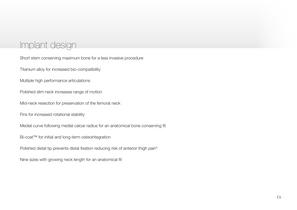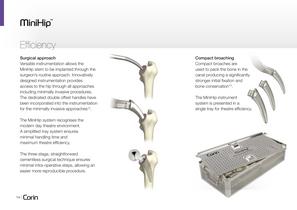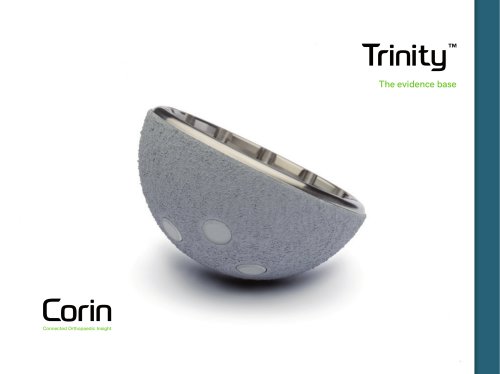 Website:
Corin
Website:
Corin
Catalog excerpts

MiniHip™ Bone Conserving Hip Replacement Design rationale |1
Open the catalog to page 1
MiniHip™ Introduction Patient demographics have changed over time, such that today’s patients are of a younger average age1 and have a longer life expectancy. They also make higher demands on their implants in order to meet their greater expectations of activity levels1,2. Although hip resurfacing and total hip replacement (THR) have proved to be successful choices for joint replacement in the past, current literature suggests that these are not always the perfect solution1,2,3. Resurfacing has proven to be particularly successful for young active patients, although it has been identified...
Open the catalog to page 2
Bone conserving hip replacement for active patients |3
Open the catalog to page 3
MiniHip™ Implant design MiniHip is a bone conserving hip replacement that applies 20 years of expertise in bearing technology and proven cementless fixation to combine the benefits of hip resurfacing and THR, providing a versatile and efficient solution that meets the changing demands of patients. The MiniHip implant design is based on extensive analysis of computerised tomography (CT) scans of natural femurs; this data was used to define the optimal geometry, neck length and size range of the prostheses4. Further finite element analysis (FEA) was performed to determine the loading,...
Open the catalog to page 4
Implant design Short stem conserving maximum bone for a less invasive procedure Titanium alloy for increased bio-compatibility Multiple high performance articulations Polished slim neck increases range of motion Mid-neck resection for preservation of the femoral neck Fins for increased rotational stability Medial curve following medial calcar radius for an anatomical bone conserving fit Bi-coat™ for initial and long-term osteointegration Polished distal tip prevents distal fixation reducing risk of anterior thigh pain5 Nine sizes with growing neck length for an anatomical fit |5
Open the catalog to page 5
MiniHip™ Activity Designed for conservation The MiniHip has been specifically designed to be implanted using a mid-neck resection, facilitating a highly bone conserving procedure that retains the femoral neck and leaves the diaphysis intact. The implant is designed such that it uses a ‘round the corner’ technique to follow the natural curvature of the medial calcar, preventing breach of the greater trocanter and allowing less invasive approaches. Designed for proximal fit and fill The geometry of the MiniHip prosthesis is based on a detailed analysis of extensive CT scans in combination...
Open the catalog to page 6
Validation of the analysis was achieved through the virtual implantation of each implant size into a typical femur selected from the appropriate size cluster5. Designed for stability By achieving excellent fit through patientdriven design, the MiniHip implant has an enduring primary fixation. The initial scratch fit of the cementless Bi-coat surface creates a high coefficient of friction, giving secure primary fixation. The anti-rotational fins add stability in the torsional plane to keep micromotions to a minimum. Long-term fixation and ongoing stability is also achieved through the...
Open the catalog to page 7
6. DISCUSSION The stress and micromotion analyses give an overall representation of the influence of implanting the Mini-Stem into a previously intact femur. There was a clear, and expected, change in the tensile and MiniHip™ compressive stresses of the bone following implantation. Stress-shielding was observed at the medial aspect of the femur (in the cortical bone) and the top of the greater trochanter, as the load was predominantly transferred from the implant in two directions: onto the proximal calcar region (white arrow) and the bone adjacent to the distal, lateral end of the implant...
Open the catalog to page 8
Designed for increased mobility High activity levels also demand a high range of motion. The MiniHip is designed with a low profile neck and taper to maximise the head/neck ratio, and thus maximise the safe range of motion for the implant. The neck profile has been designed to maximise the range of motion without compromise to the strength of the implant and as such, the neck has been designed to meet the highest international standards for fatigue strength. Posterior Lateral Medial 226° Anterior 127° Abduction/adduction Anterior Internal/external rotation Posterior 188° Flexion/extension |9
Open the catalog to page 9
MiniHip™ Versatility Single system The MiniHip system has been specifically designed for use alongside the Cormet resurfacing and Metafix cementless hip systems in order to provide a solution that caters for a wide range of patient indications and provides the most accurate solution for their anatomy. 10 |
Open the catalog to page 10
The implant and instrumentation combinations allow a seamless transition from a Cormet resurfacing, through a MiniHip bone conserving replacement to a Metafix total hip, allowing both pre-operative and intra-operative flexibility. Ne ck len gt h ‘N ’ Patient matched solutions Femoral offset has been recognised as a critical factor in restoring the biomechanics of the hip following a joint replacement procedure10,11. The MiniHip implant range offers a dynamic offset and neck length that increases as the stem length increases, allowing an anatomic implant suited to the patient. Size 1 2 3 4 5...
Open the catalog to page 11
MiniHip™ A pre-operative and intra-operative choice of articulation specific to the patient’s activity requirements is available for use with the MiniHip system. The modular head of each bearing couple, including the largest of the Optimom heads, has been tested and validated for use with the universally accepted 12/14 trunnion of the MiniHip stem. 12 |
Open the catalog to page 12
MiniHip™ Efficiency Surgical approach Versatile instrumentation allows the MiniHip stem to be implanted through the surgeon’s routine approach. Innovatively designed instrumentation provides access to the hip through all approaches including minimally invasive procedures. The dedicated double offset handles have been incorporated into the instrumentation for the minimally invasive approaches12. The MiniHip system recognises the modern day theatre environment. A simplified tray system ensures minimal handling time and maximum theatre efficiency. The three stage, straightforward cementless...
Open the catalog to page 14All Corin catalogs and technical brochures
-
Dynacup One-C™
4 Pages
-
MiniHip™ - The evidence base
16 Pages
-
MiniHip™ - product overview
12 Pages
-
Trinity™ - surgical technique
16 Pages
-
Trinity - design rationale
12 Pages
-
Biomimetic Cementless Technology
12 Pages
-
ECiMa™
12 Pages
-
TriFit TS™
12 Pages
-
Trinity™ - product overview
12 Pages
-
Optimized Positioning System
12 Pages
-
Unity knee surgical technique
24 Pages
-
TriFit TS surgical technique
12 Pages
-
MiniHip™ - surgical technique
12 Pages
-
OPS™
6 Pages
-
Unity KneeTM
16 Pages
-
TriFit TS?
12 Pages
-
MiniHip - product overview
12 Pages
-
Trinity
12 Pages






















